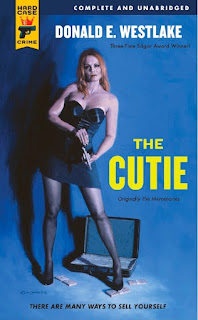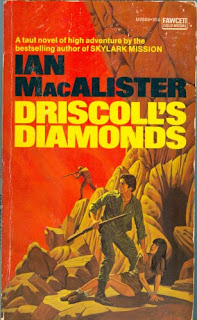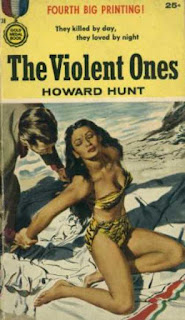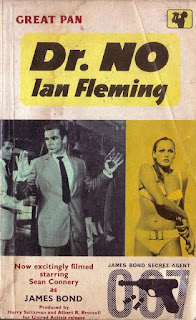This is also a Simon Templar who is unambiguously and unapologetically a thief and a crook. At this stage he’s a slightly more ethical version of Raffles. Raffles only steals from those who can afford the loss. Simon Templar steals from other crooks and from people who (in his opinion) deserve to be robbed.
This is also a Saint who still works with accomplices including the great love of his life, Patricia Holm. He has not yet become a loner.
All the stories in this collection deal with confidence tricks of some kind, or more specifically they deal with the Saint meting out justice to con-men while enriching himself in a most satisfying way. The confidence tricks are many and varied.
In The Brain Workers Simon rescues a young lady named Ruth Eden who had been attracting unwelcome attentions from her sleazy employer. Ruth has been forced to take on secretarial work after her mother was swindled into buying worthless shares. The Saint has a notion that he may be able to retrieve some of those losses for her. And dealing out justice to swindlers gives him an inordinate amount of pleasure. He may not even have to resort to violence. A very typical but effective Saintly adventure.
In The Export Trade Simon is hired by a solicitor to take a very valuable package to Paris. Simon has every intention of carrying out this commission honestly and faithfully. He is not supposed to open the package but his curiosity tempts him, and he believes one should always succumb to temptation. In this case it turns out to be a profitable decision. A very good story.
The Unblemished Bootlegger is another opportunity for Simon to mete out justice to a swindler (who in this case happens to be a bootlegger as well). Simon disapproves very strongly of swindlers and finds that the best way to deal with is by - swindling them. In this case he takes a different but equally effective approach. It’s unfortunate for this swindler that he doesn’t like the sea. Another good story.
The Owner’s Handicap takes Simon to the races where he becomes extremely interested in a racing scam. Simon knows a few scams of his own, all in a good cause of course. A pretty decent story.
The Tough Egg pits Simon against American gangster Max Kemmler who is making a lot of money from a gambling club in London. The Saint feels that it really would be highly desirable to relieve Max of some of his ill-gotten gains. Max is reputed to be a tough egg, which makes the prospect even more delightful. The Saint could of course simply stage a stick-up but that would be boring and lacking in style and that would deprive the exercise of most of its pleasure. It would be much more fun if Max could be persuaded to take an active part in his own fleecing. Another fine little tale.
The Bad Baron presents Simon with a rival. The Fox has quickly become an even more celebrated thief than the Saint. As for the baron, he owns a fabulously valuable jewel which is going to tempt both the Fox and the Saint. This one has a clever and unexpected, and untypical, ending. It’s a very good story.
The Brass Buddha is a story about a simple con game but with complications. It’s amazing that Charteris was able to write so many stories on this theme while giving each one a slightly different twist. A solid story.
In The Perfect Crime Simon pulls off a remarkably audacious con (with a sleazy money lender as the victim) that even Chief Inspector Teal seems impressed by. Teal knows exactly how Simon did it but there’s absolutely nothing he can do about it. A delightful story.
In The Appalling Politician the Saint gets to act as detective, working hand-in-glove with none other than Chief Inspector Claud Eustace Teal. A very sensitive trade treaty has been stolen and it was a most puzzling crime. Simon discovers that solving mysteries can be almost as much fun as committing crimes, especially when he’s allowed to use his own distinctive methods. Quite a good story.
The Unpopular Landlord, Major Bellingford Smart, isn’t just unpopular. He’s a ruthless crook who mercilessly exploits his tenants. And he’s a crook for whom the Saint has plans. Those plans also involve the Countess of Albury’s diamonds. It’s always worth killing two birds with one stone. A good story.
The New Swindle concerns two con-men, one of whom is a renowned card sharp. They believe they really have found the Holy Grail - a brand-new swindle. The beauty of it is, if it works properly there’s nothing anybody can do about it. The only thing that could possible go wrong would be if Simon Templar decided to take a hand in things. A decent story.
In The Five-thousand-pound Kiss Simon renews an acquaintanceship with a competitor. She happens to be interested in a certain diamond which has also attracted the Saint’s attention. The end result is not what the Saint expected, but then the unexpected rather appeals to him.
The Green Goods Man deals with another very clever con involving the selling of real banknotes. How do you make a profit from selling real rather than counterfeit banknotes? That’s the beauty of the green goods con. And how do you turn such a con back on the con-man? That requires the peculiar talents of the Saint. A clever story.
The Blind Spot is not exactly about a confidence trick as such. It’s about a shady patents lawyer. Simon saves the life of a penniless inventor who has tried to throw himself under a train. The inventor, a man named Inwood, had finally come up with an invention that might actually make money but the shady patents lawyer stole his invention. Simon might not have taken the matter any further had he not remembered another invention he came across recently. This invention didn’t work, and that’s the beauty of it. Another fine story.
The Unusual Ending pits the Saint against an old foe from one of the earlier stories, man about to head off to South America with his ill-gotten gains. The ending of this story is not what the Saint expected but it’s rather neat.
Personally I love stories about confidence tricks so it was pretty much inevitable that I was going to enjoy this collection. What’s interesting is that it includes stories in which the Saint’s motivations are entirely selfless, others in which he is motivated to a large extent by his lust for loot. There are even stories in which the Saint ends up losing, but he doesn’t really lose since it’s the adventure that matters. A fine collection. Highly recommended.
In The Brain Workers Simon rescues a young lady named Ruth Eden who had been attracting unwelcome attentions from her sleazy employer. Ruth has been forced to take on secretarial work after her mother was swindled into buying worthless shares. The Saint has a notion that he may be able to retrieve some of those losses for her. And dealing out justice to swindlers gives him an inordinate amount of pleasure. He may not even have to resort to violence. A very typical but effective Saintly adventure.
In The Export Trade Simon is hired by a solicitor to take a very valuable package to Paris. Simon has every intention of carrying out this commission honestly and faithfully. He is not supposed to open the package but his curiosity tempts him, and he believes one should always succumb to temptation. In this case it turns out to be a profitable decision. A very good story.
The Unblemished Bootlegger is another opportunity for Simon to mete out justice to a swindler (who in this case happens to be a bootlegger as well). Simon disapproves very strongly of swindlers and finds that the best way to deal with is by - swindling them. In this case he takes a different but equally effective approach. It’s unfortunate for this swindler that he doesn’t like the sea. Another good story.
The Owner’s Handicap takes Simon to the races where he becomes extremely interested in a racing scam. Simon knows a few scams of his own, all in a good cause of course. A pretty decent story.
The Tough Egg pits Simon against American gangster Max Kemmler who is making a lot of money from a gambling club in London. The Saint feels that it really would be highly desirable to relieve Max of some of his ill-gotten gains. Max is reputed to be a tough egg, which makes the prospect even more delightful. The Saint could of course simply stage a stick-up but that would be boring and lacking in style and that would deprive the exercise of most of its pleasure. It would be much more fun if Max could be persuaded to take an active part in his own fleecing. Another fine little tale.
The Bad Baron presents Simon with a rival. The Fox has quickly become an even more celebrated thief than the Saint. As for the baron, he owns a fabulously valuable jewel which is going to tempt both the Fox and the Saint. This one has a clever and unexpected, and untypical, ending. It’s a very good story.
The Brass Buddha is a story about a simple con game but with complications. It’s amazing that Charteris was able to write so many stories on this theme while giving each one a slightly different twist. A solid story.
In The Perfect Crime Simon pulls off a remarkably audacious con (with a sleazy money lender as the victim) that even Chief Inspector Teal seems impressed by. Teal knows exactly how Simon did it but there’s absolutely nothing he can do about it. A delightful story.
In The Appalling Politician the Saint gets to act as detective, working hand-in-glove with none other than Chief Inspector Claud Eustace Teal. A very sensitive trade treaty has been stolen and it was a most puzzling crime. Simon discovers that solving mysteries can be almost as much fun as committing crimes, especially when he’s allowed to use his own distinctive methods. Quite a good story.
The Unpopular Landlord, Major Bellingford Smart, isn’t just unpopular. He’s a ruthless crook who mercilessly exploits his tenants. And he’s a crook for whom the Saint has plans. Those plans also involve the Countess of Albury’s diamonds. It’s always worth killing two birds with one stone. A good story.
The New Swindle concerns two con-men, one of whom is a renowned card sharp. They believe they really have found the Holy Grail - a brand-new swindle. The beauty of it is, if it works properly there’s nothing anybody can do about it. The only thing that could possible go wrong would be if Simon Templar decided to take a hand in things. A decent story.
In The Five-thousand-pound Kiss Simon renews an acquaintanceship with a competitor. She happens to be interested in a certain diamond which has also attracted the Saint’s attention. The end result is not what the Saint expected, but then the unexpected rather appeals to him.
The Green Goods Man deals with another very clever con involving the selling of real banknotes. How do you make a profit from selling real rather than counterfeit banknotes? That’s the beauty of the green goods con. And how do you turn such a con back on the con-man? That requires the peculiar talents of the Saint. A clever story.
The Blind Spot is not exactly about a confidence trick as such. It’s about a shady patents lawyer. Simon saves the life of a penniless inventor who has tried to throw himself under a train. The inventor, a man named Inwood, had finally come up with an invention that might actually make money but the shady patents lawyer stole his invention. Simon might not have taken the matter any further had he not remembered another invention he came across recently. This invention didn’t work, and that’s the beauty of it. Another fine story.
The Unusual Ending pits the Saint against an old foe from one of the earlier stories, man about to head off to South America with his ill-gotten gains. The ending of this story is not what the Saint expected but it’s rather neat.
Personally I love stories about confidence tricks so it was pretty much inevitable that I was going to enjoy this collection. What’s interesting is that it includes stories in which the Saint’s motivations are entirely selfless, others in which he is motivated to a large extent by his lust for loot. There are even stories in which the Saint ends up losing, but he doesn’t really lose since it’s the adventure that matters. A fine collection. Highly recommended.
























